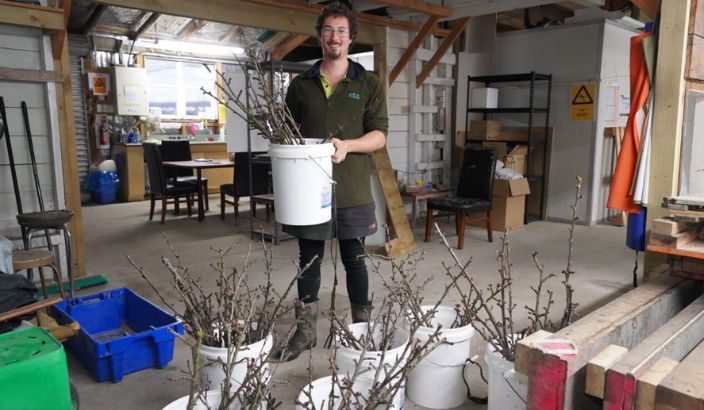Samuel swaps cherry insights


Cherrybank Orchard manager Samuel Lee spends a rainy day sorting cherry trimmings for further research in his tree flowering model. Photo: William Woodworth.
The next crop of Cherrybank cherries will benefit from knowledge gained at a globally important research event.
Cherrybank orchard manager Samuel Lee recently attended the International Society for Horticultural Science’s 10th International Cherry Symposium in Washington State, joining scientists and growers from around the world to share research, explore the future of production and tackle the varied difficulties facing the fruit.
Samuel was one of five New Zealanders selected through a Summerfruit New Zealand scholarship, supported by MG Marketing, and took the opportunity to learn from international experts in the field while imparting some of his own research.
“The quality marker of a cherry is its firmness, size and brix measurement, which as a domestic-only producer we aim for, but the orchard tours showed me American growers focus on volume for domestic market with Giesler rootstocks, while we prioritize size and quality using mostly only the one Colt rootstock.
“A big key takeaway for me was that calcium is a crucial element of cell division during the formation of the fruit in the pip hardening stage, but because it’s such a large molecule the trees can struggle to use it efficiently so there’s much research going into absorption of it into the trees.
“Climate change is a key issue, as cherries need a set amount of ‘chill’ hours below seven degrees and then need to warm up again for a great product, so scientists are tackling that with both climate research for future growing areas and fruit research for no-chill cherries.”
Samuel also shared his research on cherry fruit size potential with different aged branches using upward fruiting techniques, building a digital model after “far too much measuring” as part of the symposium’s ‘poster sessions’.
His presentation focused on optimizing cherry tree productivity by analyzing the relationship between branch age and fruiting potential, finding a large dip off in effectiveness after six years of a branch flowering but found different aged branches on the same segment could maximise crops.
Upcoming work with Plant and Food Research also promises more knowledge around artificial pollination techniques to improve local horticultural practices into the future.
“There are different issues impacting cherry production in different growing areas around the world, but many are standard for everyone like rain covers to stop splitting, sun covers to prevent doubling, tree nutrition, genetic editing possibilities and disease prevention”, added Samuel.
“I was really fascinated by the sniffer dogs they’ve trained to detect Little Cherry Disease when it gets too warm or humid in summer during floral induction – researchers don’t even quite know how the dogs do it yet.
“But having the Cherrybank owners Blair and Mel McLean accompany me, as well as Simon and Scott Bishell, we had a good little Blenheim crew there among all of our fellow Kiwi growers.”

